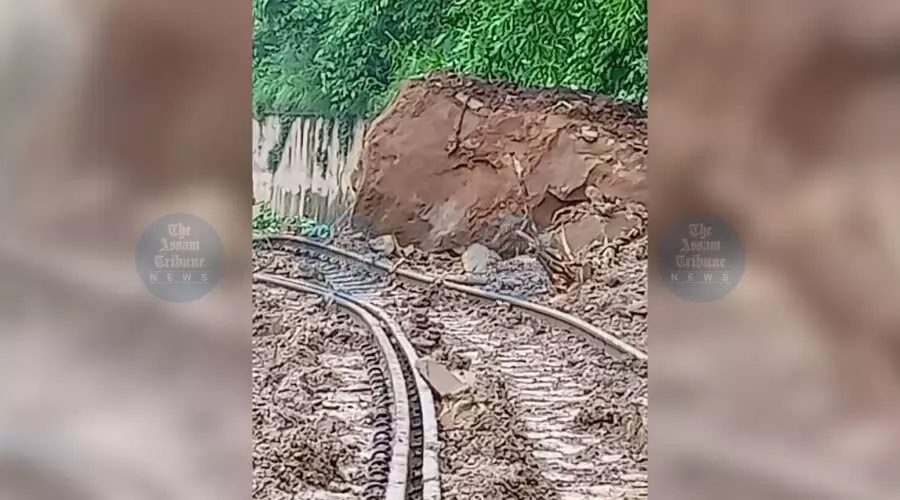Why Barak Valley needs Lanka–Silchar alternate rail route now more than ever
A region left stranded each monsoon awaits a lifeline that promises resilience, safety & connection

A still of the Lumding-Badarpur rail link disrupted by massive landslide (AT Photo)
Silchar, July 7: Every time a landslide strikes the Lumding–Badarpur hill section, life in Barak Valley comes to a standstill. For residents of southern Assam, it’s not just a natural event—it’s a recurring crisis.
This year alone, multiple landslides between Jatinga, Mupa, and other geologically fragile stretches—including the latest on Monday near the 51/1-2 km mark at Mupa–Dihakho station—have severely disrupted train services.
Each time, railway workers spring into action, clearing debris and painstakingly restoring connectivity. But the larger question persists - how long can this cycle continue?
The Lumding–Badarpur section, carved through the undulating hills of Dima Hasao, was converted to broad gauge in 2015.
However, the region’s volatile geology and relentless monsoons have rendered the section increasingly unreliable in recent years.
The consequences go far beyond mere inconvenience—it disrupts trade, travel, tourism, and even medical emergencies, effectively isolating the Barak Valley every time nature strikes.
Amid this recurring crisis, a proposed 160-km alternative railway alignment from Lanka to Silchar via Chandranathpur has emerged as a beacon of hope.
The project—already drawing significant attention from both local residents and the Centre—is currently under active consideration by the Ministry of Railways.
According to sources, under the leadership of Union Railway Minister Ashwini Vaishnaw, the proposal is being accorded high priority and is likely to receive final approval within the next six months.
The development has sparked renewed optimism among the nearly 40 lakh residents of Barak Valley, who have long awaited a safe and reliable railway lifeline.
RTI-driven momentum
A large section of the public across Barak Valley—including veterans, civic groups, and concerned citizens—believes the significance of the proposed alternate railway route extends far beyond logistical ease.
To them, it symbolises resilience, connectivity, and long-overdue regional inclusion.
In November last year, Haridas Dutta, General Secretary of the Nagarik Swarth Raksha Sangram Parishad—a prominent citizens’ forum—filed an RTI query with the Northeast Frontier Railway (NFR) to verify whether the survey for the new track had been formally approved by the Railway Board.
In its reply dated November 22, NFR confirmed that the survey had indeed been sanctioned, with work commencing on May 24, 2023. The project is slated for completion by February 2025 at an estimated cost of Rs 20.72 crore.
Following up in June this year, Dutta filed another RTI seeking the updated timeline for the survey’s completion, the status of the Detailed Project Report (DPR), and the proposed list of stations along the Lanka–Silchar route via Chandranathpur.
“I filed the RTI on June 27 and am awaiting a response,” he said. According to Dutta, unlike the existing alignment that traverses hazardous, high-altitude terrain, the proposed route is expected to follow a lower, more geologically stable corridor—less vulnerable to landslides, washouts, and seismic disturbances that have repeatedly crippled the current hill section over the past decade.
Plea for priority
Rajya Sabha MP Kanad Purkayastha told The Assam Tribune that he met Union Railways Minister Ashwini Vaishnaw in New Delhi on June 25 to raise concerns over the recurring landslides and service disruptions on the Lumding–Silchar railway line.
During the meeting, Purkayastha urged the Union Minister to fast-track the proposed alternate railway alignment via Lanka.
“I was informed that the survey for the alternate route has been completed, and physical verification for track laying is set to begin soon. The Honourable Union Minister responded positively and assured me that the people of Barak Valley and neighbouring states will hear good news within six months,” he said.
Meanwhile, Rajya Sabha MP from West Bengal and former Silchar MP, Sushmita Dev, called for political unity in pushing for the early execution of the Lanka–Silchar line.
“Given the repeated disruptions due to landslides, the key question is - which route is truly all-weather, capable of reliably connecting Barak Valley to the rest of India? The alternate Lanka route has been a longstanding demand, dating back over a decade,” Dev said.
She added that hill railway sections in states like Assam are particularly prone to weather-related disruptions. “The very first monsoon after broad gauge was introduced in Barak Valley exposed the vulnerability of the Lumding route. Let’s set politics aside. There must be an alternate route via Lanka, or Barak Valley will face isolation every monsoon,” Dev asserted.
As landslides continue to sever crucial links, many in Barak Valley are cautiously optimistic about the government’s assurances. But local voices stress that optimism must now translate into swift action. Delays, they warn, could derail a project of critical strategic and humanitarian importance.
For Barak Valley—a region long viewed as peripheral to mainstream infrastructure policy—the Lanka–Silchar rail line is more than just a track.
It’s a long-overdue promise of security, connectivity, and inclusion — a chance to safeguard lives and livelihoods from being buried under boulders, severed links, and bureaucratic inertia.
